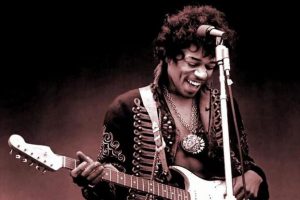Rock Music in Thailand
Contents

In the captivating world of musical exploration, rock music emerges as a force to be reckoned with. A vibrant canvas of rebellious hues and raw emotions, rock marked its place in sonic history through amplified guitars, pulsating basslines, and thunderous drums. The global narrative of rock music unfolds across decades, weaving through diverse cultures. In Thailand, a fascinating episode of rock’s journey is revealed—a narrative mirroring its evolution from Western origins to seamless integration into the rich tapestry of Thai musical expression.
Embarking on this sonic journey invites exploration into the captivating history, pulsating beats, and rebellious spirit defining the unique resonance of rock music in the Land of Smiles. As rock threads itself into the cultural tapestry, each note contributes to the rich, ever-expanding fabric of musical expression, leaving an indelible mark on the soul of Thai music.
Characteristics
While the characteristics of Thai rock can be varied and nuanced, we would like to highlight some aspects the we find intriguing and reflective of the Thai people’s character.
- Fusion of Global and Local Influences:
Thai rock music’s distinctive charm emanates from its seamless fusion of global influences and local elements, creating a sonic tapestry that resonates with the cultural intricacies of Thailand. This fusion is not a mere juxtaposition but an organic integration that breathes life into the genre. For instance, traditional Thai musical elements, such as the resonant tones of the khaen (a bamboo mouth organ) or the melodic richness of the ranad (xylophone), are woven into the fabric of rock compositions. This amalgamation of modern rock instrumentation with traditional Thai sounds results in a harmonious blend, offering listeners a unique auditory experience that reflects the cultural identity of Thailand.
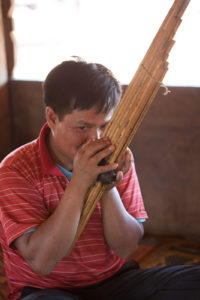
Khaen
- Thai Poetry Lyrics and Western Music Compatibility:
The lyrical landscape of Thai rock music stands as a testament to its charm and cultural depth. Pioneering bands like Carabao are celebrated for their masterful integration of Thai poetry into their lyrics. Thai poetry, with its profound cultural resonance, finds an unexpected yet harmonious partner in Western musical elements. This compatibility adds a layer of complexity and richness to Thai rock, elevating it beyond a mere musical genre. Carabao’s lyrical finesse, often addressing socio-political issues and cultural nuances specific to Thailand, showcases the mastery of Thai people in crafting lines, poems, and melodies that resonate with the hearts and minds of the audience.
- Diverse Sub-Genres:
The diversity within Thai rock music is vividly showcased through a wide spectrum of sub-genres, each adding layers to the genre’s multifaceted nature. A notable example is the emergence of “phleng phuea chiwit,” a sub-genre popularized by Carabao. This unique fusion intricately blends Western folk influences with Thai folk music, resulting in a distinct sonic landscape. Beyond its musical innovation, it serves as a powerful vehicle for social commentary, focusing on the struggles of working-class citizens. This sub-genre exemplifies how Thai rock transcends mere entertainment, becoming a poignant commentary on societal issues. Carabao, as pioneers in this movement, delves into themes such as labor and democracy, using their music as a conduit for cultural reflection.
Furthermore, the exploration of “Luk Thung Rock” introduces a distinctive flavor to Thai rock music, combining the roots of Luk Thung, a traditional Thai genre, with the energy of rock. This sub-genre offers a nostalgic yet contemporary musical experience, showcasing the genre’s ability to adapt and evolve over time. Artists like Seksan Sukpimai, known as “Suthep,” have significantly contributed to the Luk Thung Rock movement, further expanding the boundaries of Thai rock.
- Social Role of Rock in Thailand:
From electrifying riffs to poignant lyrics, Thai rock resonates far beyond the concert hall. Emerging in the wake of social and political upheaval, it carved a space for rebellion and reflection, channeling the struggles of the working class and the yearning for democracy into anthems that ignited a generation. Iconic figures like Asanee-Wasan electrified audiences with their dynamic live shows, while songs like Carabao’s “Lam Poo Khao” and Luk Thungdara’s “Khon Lao Jaew” became sonic mirrors, reflecting the harsh realities of everyday life. This potent blend of cultural awareness and raw energy gave Thai rock a distinct identity on the global stage, reminding us that music can be not just entertainment, but a powerful catalyst for social change.
History
In the late 60s and early 70s, the seeds of rock music found fertile ground in Thailand, a phenomenon intricately linked to the Vietnam War. This musical revolution stemmed from American soldiers stationed in Sattaheep and Udon Thani, notably at the U-tapao military base, where the resonating beats of rock became an essential part of the cultural exchange. Simultaneously in Europe, the emergence of esteemed rock bands like Led Zeppelin in 1968 signaled a departure from the rock and roll era epitomized by Elvis Presley.
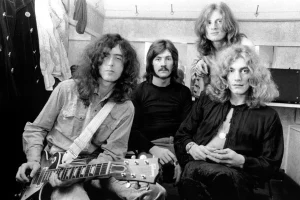
Led Zeppelin
Cr. rollingstone.com

Elvis Presley
Cr. abcnews.go.com
It’s imperative to discern the distinctions between the rock of that era and its contemporary counterpart. Categorized into hard rock and heavy metal, the former era’s rock was characterized by complexity, with heavy metal embracing simpler yet louder and more powerful beats, distinguishing itself from hard rock, where simultaneous guitar and bass solos set a slower-paced tone. The inaugural era of Thai rock music positioned itself between heavy metal and hard rock, paving the way for sub-genres such as glam rock, alternative rock, garage, grunge, and emo to flourish.
During this transformative time, bands like “V.I.P.,” featuring the notable Olan Pongjai (โอฬาร พรหมใจ) and Kitti Guitar Gun (กิตติ กีตาร์ปืน), ascended to prominence, making a significant impact on the musical landscape. Renowned for their rock and roll performances, particularly in the heavy metal style, V.I.P. played in pubs and various entertainment venues, captivating American conscripts during the Vietnam War. Lam Morrison (แหลม มอร์ริสัน), a stage name derived from his idol, is closely linked to the V.I.P. era, becoming synonymous with the period. Renowned for his distinctive hoarse cry, Morrison carved out a niche by skillfully playing songs from Jim Morrison, the lead singer of The Doors—an iconic American rock band of that time. His ability to emulate Jim Morrison’s vocal style and musical prowess set him apart, a rarity among Thai singers and musicians. The band’s reputation soared, leading them to perform in Germany for an entire decade, leaving an indelible mark on Thailand’s rock music scene.
During the 60s and 70s, these bands primarily entertained foreign audiences, with V.I.P. reigning supreme in the 1960s. The 1970s brought the Butterfly band (บัตเตอร์ฟลาย), solidifying rock’s presence in Thailand. By 1982, the rock scene witnessed the emergence of influential bands like The Olarn Project (ดิ โอฬาร โปรเจ็คต์), Neua Gub Nang (เนื้อกับหนัง), and Rockestra (ร็อคเคสตร้า). Figures like Asanee-Wasan (อัสนี-วสันต์) and Micro (ไมโคร), signed with GMM Grammy, one of Thailand’s biggest record labels, further elevated Thai Rock’s status. New sub-genres, including phleng phuea chiwit, blended Western folk and rock influences, focusing on themes of labor and hardships, championing democracy for working-class citizens in Thailand. This dynamic evolution cements rock music’s enduring legacy, weaving its narrative into the cultural fabric of Thailand.
1960s-1970s:
In the vibrant musical landscape of the 1960s and 1970s, rock music made its mark on Thailand, drawing inspiration from the blues rock foundation that had gained international acclaim through iconic bands such as The Doors and the legendary musician Jimi Hendrix. Within this dynamic global movement, the Thai rock genre took its initial steps, fueled by the performances of Lam Morrison and Kitti Kanchanasathit, who notably entertained American soldiers stationed in Thailand during the Vietnam War.
Jimi Hendrix
Cr. military.com
V.I.P. (late 1960s)
A key pioneer in the Thai rock scene, V.I.P. emerged almost four decades ago, signifying a pivotal chapter in the country’s rock music narrative. The late ’60s witnessed the String Combo competition of 1969, where “The Impossible,” performed by V.I.P., secured notable victories. The mid-1970s, known as the G.I. era during the Vietnam War, fostered a vibrant musical scene, attracting soldiers in search of entertainment to Thailand. Against this backdrop, the illustrious rock band from Udon Thani rose to prominence, showcasing exceptional musical prowess.
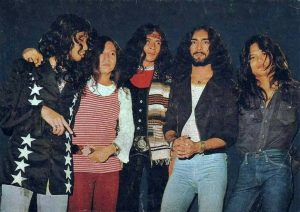
V.I.P
Cr. The Rock Pub – Bangkok`s House Of Rock
The original V.I.P. lineup included Wichai Nuanjam, acclaimed as “Lam Morrison” on guitar, Pang Niwat Kongkaew on bass, Win Khammi on organ, and the skilled two-legged drummer, Ekaman Phophanthong. Later, Oh Olarn Phromjai joined as a guitarist, contributing to the band’s evolving sound. Celebrated for his distinctive high-pitched singing voice, Lam Morrison earned the moniker “Guitar King” of Thailand, a title solidified after winning a competition in Germany in 1980. This accolade not only acknowledged his exceptional talent but also elevated V.I.P.’s reputation, with foreigners honoring Lam Morrison as the Guitar King of Thailand.
Among V.I.P.’s notable songs, “Morrison” stands as a tribute, reflecting the band’s unique blend of rock and roll infused with a distinct Thai twist. This track serves as a testament to V.I.P.’s enduring legacy and their influential role in shaping the trajectory of rock music in Thailand.
Example Song: “Morrison” (มอร์ริสัน) pays tribute to the band’s connection with Laem Morrison, showcasing their ability to seamlessly blend rock and roll with a distinct Thai twist.
Butterfly (1978)
Butterfly played a vital role in shaping its modern direction. Founded in 1978 by Jiraphan Angsawanon, Surasee Itthikul, Danu Huntrakul, and Krit Chokthippatthana, Butterfly became a cornerstone in Thai music. The band, which included visionaries like Bruce Gaston, Asanee Chotikul, Ukrit Plankkun, Karanet Wasinon, Khet Aran Lertpipat, Anuwat Suebsuwan, Sinnapa Sarasas, and Saksit Chueklang, went beyond traditional music production. They established Butterfly Sound and Film Services Company Limited, creating soundtracks for movies, ads, stage plays, and albums, marking a transformative chapter in Thai music history.
Example Song: “Rock Machine” (ร็อคแมชชีน) is a late ’70s classic, this song encapsulates Butterfly’s rebellious spirit with its lively rhythm and rock-infused sound, showcasing the band’s profound impact on Thai music.
1980s-1990s:
In this decade, notable rock bands such as The Olarn Project (ดิ โอฬาร โปรเจกต์), Neua Gub Nang (เนื้อกับหนัง), and Rockestra (ร็อคเคสตร้า) emerged. Among them, Asanee-Wasan (อัสนี-วสันต์) and Micro (ไมโคร), both under the GMM Grammy label, achieved significant success. Carabao (คาราบาว) played a pivotal role in popularizing the phleng phuea chiwit (เพลงเพื่อชีวิต) genre, an infusion of rock elements, with their album “Made in Thailand” (เมดอินไทยแลนด์), selling over five million copies.
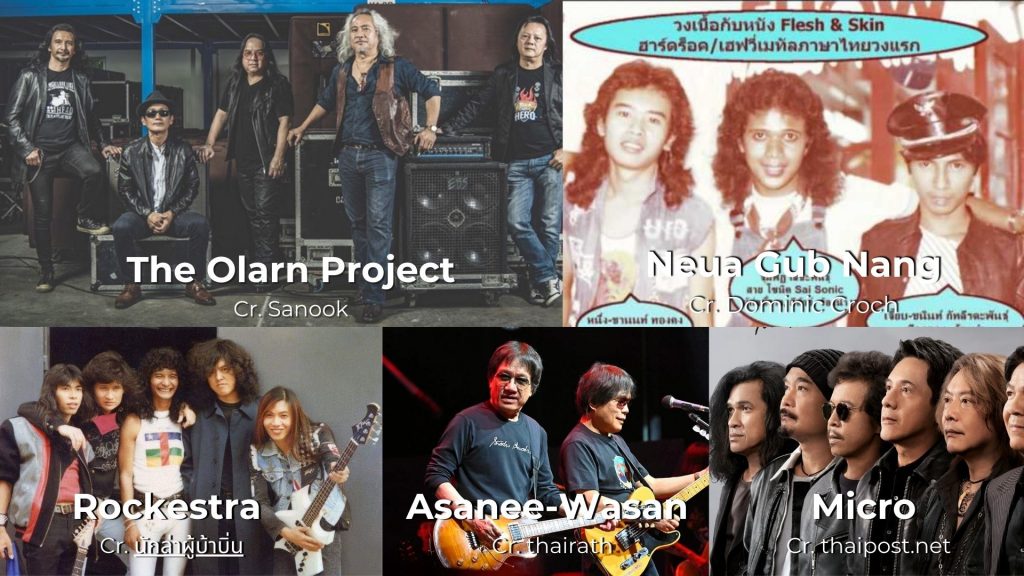
Carabao (1981)
Carabao stands as a cultural phenomenon that transcends musical boundaries. Formed in 1981, the band is synonymous with a revolutionary approach to rock music, seamlessly blending traditional Thai elements with global rock influences. Fronted by the charismatic and socially conscious Yuenyong Opakul (ยืนยงโอภากุล), known as Aed Carabao (แอ๊ด คาราบาว), the band has become an institution in Thai music, using their platform not only for musical expression but also as a powerful tool for social commentary.
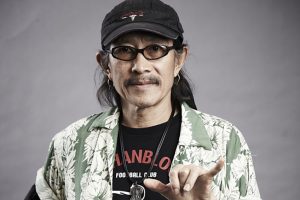
Aed Carabao (Yuenyong Opakul)
Cr. music.trueid.net
Carabao’s music is a rich fabric that intricately weaves together diverse genres, from rock and folk to reggae and more. Their iconic song “Made in Thailand” is a national anthem of sorts, celebrating Thai identity with infectious energy. Beyond catchy tunes, Carabao distinguishes itself through socially relevant lyrics, addressing issues such as environmental conservation, social justice, and the struggles of the marginalized.
With a commitment to authenticity and a distinctive fusion of sounds, Carabao has made an enduring impact on the international Thai music industry. Their enduring popularity is not just about musical innovation but also about championing causes that resonate with the hearts of their fans.
Example Song: “Made in Thailand” (เมดอินไทยแลนด์) is perhaps one of Carabao’s most iconic songs, celebrating Thai identity and culture. Its catchy melody and patriotic lyrics have made it a cultural anthem.
“Made in Thailand” by Carabao
Rockestra (1982)
Rockestra stands as a testament to the enduring spirit of rock in the Land of Smiles. Formed with a vision to deliver electrifying performances and push musical boundaries, Rockestra has become a stalwart in the realm of Thai rock.
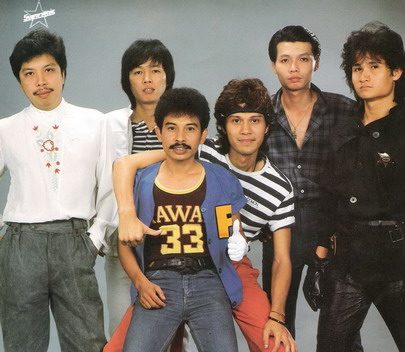
Rockestra
Cr. th.wikipedia.org
Founded by visionary musicians who share an unyielding passion for rock, the band has carved its niche with a fusion of powerful instrumentals, emotive vocals, and thought-provoking lyrics. Rockestra’s musical odyssey is characterized by a dynamic range of compositions that seamlessly blend rock elements with poignant storytelling.
The band’s distinctive sound, marked by soaring melodies and intricate arrangements, captures the essence of rock’s rebellious spirit while embracing the rich cultural tapestry of Thailand. Each performance becomes a sonic journey, taking audiences through a landscape where raw energy converges with profound lyricism.
Example Song: “Ruk” (รัก) is a musical journey that opens with a playful dance between notes, instantly captivating listeners with the delightful touch of a saxophone. The soothing melodies, carefully crafted with the timeless resonance of the saxophone and the gentle strumming of a guitar, create an atmosphere of pure serenity.
“Ruk” by Rockestra
The Olarn Project (1984)
The Olarn Project was active during the late 1980s, gaining recognition for its metal and guitar-hero style. Setting itself apart during an era when rock music was gaining momentum in the country, The Olarn Project became notable for its unique contributions.
Led by O-larn Promjai (โอฬาร พรหมใจ) and Pathompong Sombatphibun (ปฐมพงศ์ สมบัติพิบูล), also known as Pong Hin Lek Fai (โป่ง หินเหล็กไฟ), the band gained fame for its innovative approach to rock music. They released their debut album titled “Kumpha Phan 2528” (กุมภาพันธ์ 2528) in the late ’80s. Noted for its musical complexity, The Olarn Project incorporated elements of heavy metal into their sound.
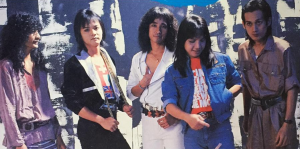
The Olarn Project
Example Song: “Thaen Kwam Huang Yai” (แทนความห่วงใย) is a sonic journey that guides listeners through the intricate landscapes of emotions. With its evocative title translating to “Replace the Concern,” the song weaves a narrative that explores the delicate balance between love and detachment.
“Thaen Kwam Huang Yai” by The Olarn Project
From the moment the first notes reverberate, a sense of contemplation permeates the air. Known for their prowess in metal and guitar-hero style, The Olarn Project delivers a compelling performance that captures the essence of the song’s theme. The intricate guitar work and dynamic arrangements reflect the complexity of emotions addressed in the lyrics.
As the music unfolds, the song becomes a meditation on the human experience—delving into the intricacies of relationships, the yearning for connection, and the simultaneous desire for emotional autonomy. The poignant lyrics, paired with the band’s skillful instrumentation, create a musical landscape that resonates with listeners on a profound level.
Asanee–Wasan (1986)
A dynamic Thai rock band, spearheaded by the charismatic brothers Asanee “Pom” (ป้อม อัสนี) and Wasan “Toe” Chotikul (โต๊ะ วสันต์ โชติกุล). Renowned for their distinctive style and musical prowess, the band gained widespread acclaim for their 1989 hit song that ingeniously encapsulates the ceremonial name for Bangkok, “Krung Thep Mahanakhon” (กรุงเทพมหานคร). Asanee, the elder brother, stands out for his electrifying guitar solos and a wild, “rock star” persona that has become iconic in the Thai rock scene. His delivery of ballads, often described as “broken-heart jiggo,” showcases a unique blend of emotion and rebellious spirit. Wasan, the bespectacled counterpart, is celebrated for his sensitive songs and a gentler musical style that complements his brother’s energy. A notable characteristic of Asanee–Wasan’s music is the inclusion of hook choruses sung by female backing vocalists, adding depth and texture to their compositions. The band’s ability to seamlessly blend the distinct musical personalities of the two brothers, coupled with their innovative approach to songwriting, has solidified their status as a significant and enduring presence in the Thai rock landscape. With hits that resonate across generations, their contribution to the Thai music scene extends beyond the realms of rock, leaving an indelible mark on the cultural tapestry of Thailand.
 Asanee–Wasan
Asanee–Wasan
Cr. sanook
Example Song: “Yin Yom” (ยินยอม) is a musical masterpiece that transcends the boundaries of time and resonates with the depths of human emotions. The song opens with a gentle acoustic guitar, setting a contemplative tone that draws listeners into its heartfelt narrative. As Asanee-Wasan’s soulful vocals come into play, “Yin Yom” becomes a journey of surrender and acceptance. The lyrics, woven with poetic finesse, explore themes of consent and acquiescence in the realm of love. The delicate balance between the melodic guitar strums and Asanee’s emotive delivery creates a harmonious blend that evokes a sense of vulnerability and authenticity. The song unfolds like a lyrical confession, inviting the audience to reflect on the complexities of relationships and the beauty found in embracing the nuances of consent. With its timeless appeal and the raw sincerity embedded in every note, “Yin Yom” stands as a testament to Asanee-Wasan’s musical prowess and his ability to capture the essence of human experience through the art of song.
“Yin Yom” by Asanee–Wasan
1990s-2000s
The 1990s marked a dynamic era for Thai rock music, witnessing the rise of heavy metal with bands like Hin Lek Fai (หินเหล็ก ไฟ). Itti Balangura (อิทธิ พลางกูร) and Chatchai Sukkhawadee (ชัชชัย สุขขาวดี) (Rang Rockestra) (หรั่ง ร็อกเคสตร้า) were notable figures during this time. In the mid-’90s, the influence of the American band Nirvana and the British band Oasis sparked the establishment of alternative and indie music in Thailand. This led to the emergence of diverse alt-rock bands, including Modern Dog (โมเดิร์นด็อก), Silly Fools (ซิลลี่ ฟูลส์), Labanoon (ลาบานูน), and Nakarin “Pang” Kingsak (ป้าง นครินทร์ กิ่งศักดิ์), shaping the vibrant landscape of Thai rock.
Hin Lek Fai (1991)
In 1993, Hin Lek Fai burst onto the music scene, becoming the most popular band before the alternative trend took over. Born from two members of the old Olarn Project, Pong Pathamapong (โป่ง ปฐมพงศ์) and Rong Narong (รงค์ ณรงค์) (bass), formed a new lineup with To Namphon (โต นำพล ) and Pop Jakkarin (ป็อป จักรรินทร์ ) playing guitar and drums, respectively. Saman Yuwunpeng (สมาน ยวนเพ็ง), a legendary Filipino drummer, joined as the new drummer. They released their debut album, sharing the band’s name, in 1993, bringing rock music back to the forefront. Almost every track in the album, including “Yom” (ยอม), “Puea Tur” (เพื่อเธอ), “Nang Maew” (นางแมว), “Phlang Rak” (พลังรัก), and “Su” (สู้), contributed to the resurgence of rock music. Before moving on to their second album, “Kon Yuklek” (คนยุคเหล็ก), in 1995, they changed drummers to Lester (เลสเตอร์), a Filipino, as Saman left to drum for Carabao. The tracks “Long Klon” (หลงกล), “Muanim” (มั่วนิ่ม), and “Kid Pai Aeng” (คิดไปเอง) also gained chart success. These two years truly marked the golden era of Hin Lek Fai, a pioneering rock band of the ’90s.
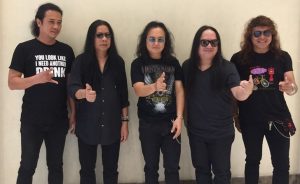
Hin Lek Fai
Cr. sanook
Example Song: “Sattha” (ศรัทธา), stands out from the band’s typical heavy metal repertoire. In contrast to the band’s heavy metal vibes, “Sattha” employs a more direct and heartfelt lyrical style. Widely recognized as a legendary cheer-up anthem, “Sattha” delivers straightforward lines that directly encourage listeners to hold onto faith and trust in their journey. The title itself, meaning “Faith” in English, encapsulates the core message of the song. Despite being released a decade ago, the song remains as remarkable and impactful as it was on its first day.
“Sattha” by Hin Lek Fai
“Sattha” has become a timeless reminder for individuals to persist, fight through challenges, and trust the process until they achieve success. The fact that even the latest generation can sing along attests to the enduring power of its message and lyrics. This anthem continues to empower people, promising to resonate and inspire for years to come.
Modern Dog (1992)
Modern Dog, a dynamic Thai rock band, emerged onto the music scene in 1992. Their inaugural album, released in 1994, quickly became a sensation, boasting an impressive 500,000 copies sold, marking the onset of their remarkable journey. Throughout their illustrious career, Modern Dog has contributed significantly to the musical landscape, delivering five studio albums that collectively garnered a staggering 2 million in sales (citation needed). In 2004, the band reached new heights with their album “That Song,” a production collaboration with Tony Doogan, known for his work with Belle & Sebastian and Mogwai. The title track, skillfully arranged by bassist Yuka Honda of Cibo Matto, added a unique flavor to the album, which also featured guest appearances by luminaries such as Yumiko Ohno of Buffalo Daughter and Sean Lennon. Notably, three singles from the album ascended to the coveted No. 1 spot on the charts in Thailand, solidifying Modern Dog’s status as a musical powerhouse.
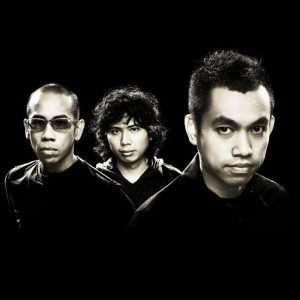
Modern Dog
Cr. sanook
Example song: “Boodsaba” (บุษบา) is a timeless rock anthem that has etched itself into the collective heart of its listeners. The song opens with a captivating intro, where powerful electric guitar lines take center stage, setting the tone for a musical journey that transcends the passage of time. Despite the years that have gone by, the song maintains its stronghold on the emotions of many, its allure undiminished.
“Boodsaba” by Modern Dog
What makes this track truly memorable is the repeated guitar line that weaves through the song, creating an irresistibly catchy rhythm. It’s a musical motif that lingers, becoming a signature element of the song’s identity. The entrance of the drums adds an extra layer of rebellious energy, prompting listeners to nod their heads in rhythmic agreement.
It is more than just a song; it’s a sonic experience that encapsulates the spirit of rock. With its powerful instrumentation, infectious melodies, and rebellious undertones, the track continues to resonate with both dedicated fans and new listeners alike.
Silly Fools (1996)
Silly Fools, a vibrant force in the Thai rock scene, burst onto the musical landscape with their distinctive sound and energetic performances. The band quickly became synonymous with raw passion and a rebellious spirit that resonated with fans across Thailand.
Renowned for their infectious melodies and powerful lyrics, Silly Fools have etched their name in the annals of Thai rock history. Their onstage presence is nothing short of electrifying, with each member bringing a unique flair to the ensemble. The band’s ability to seamlessly blend rock elements with poignant lyrics has earned them a dedicated fan base and critical acclaim.
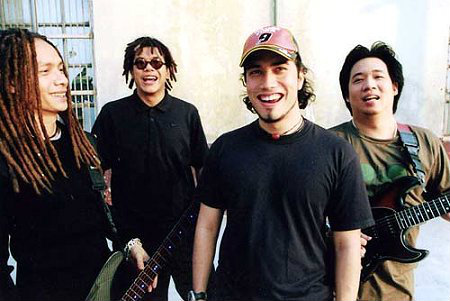
Silly Fools
Cr. sanook
Silly Fools consistently prove their prowess in crafting anthems that resonate with a diverse audience. Whether it’s the gritty guitar riffs, emotive vocals, or pulsating rhythms, Silly Fools have mastered the art of creating a sonic experience that lingers long after the last note fades. This mastery serves as a reminder that, in the realm of rock ‘n’ roll, a touch of silliness is just what people need.
Example song: “Khii Heung” (ขี้หึง) by Silly Fools is an emblematic song that showcases the band’s prowess in delivering raw and emotive rock experiences. The title, which translates to “Jealous” in English, hints at the song’s exploration of complex emotions. With gritty guitar riffs, dynamic rhythms, and impassioned vocals, Silly Fools crafts a sonic narrative that delves into the turbulent landscape of jealousy.
“Khii Heung” by Silly Fools
The song’s lyrics, penned with the band’s signature blend of sincerity and poetic expression, offer listeners a window into the intensity of longing and desire. As one of Silly Fools’ standout tracks, it exemplifies the band’s ability to capture the human experience through their unique sound, making it a cherished piece in the mosaic of Thai rock history.ส่วนบนของฟอร์มส่วนล่างของฟอร์ม
Big Ass (1996)
Big Ass has been making waves since the 1990s with their energetic performances and diverse musical style. The band’s name itself reflects their bold and impactful approach to music, embodying a spirit of authenticity and rebellion.
Known for their dynamic stage presence, Big Ass has carved a niche for themselves by seamlessly blending various genres within the rock spectrum. Their music often incorporates elements of alternative rock, punk, and post-grunge, creating a sound that resonates with a wide audience.
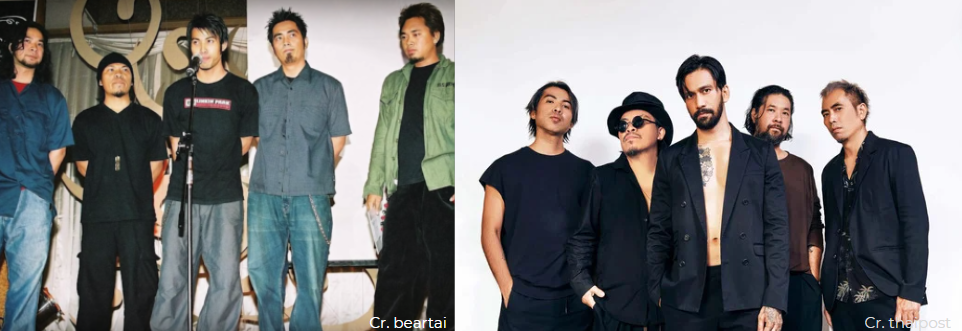
(Left) Big Ass’s original members (Right) Big Ass’s current members
The lead singer changed from ‘Ekkarat Wongchalard’ to ‘Daycha Konarlo’
Big Ass’s lyrics delve into a range of themes, from societal issues to personal struggles and introspective reflections. The band’s ability to infuse meaningful messages into their songs has contributed to their enduring popularity and critical acclaim.
Throughout their extensive career, Big Ass has not only maintained their relevance but has also evolved with the changing musical landscape. Their longevity is a testament to their adaptability and commitment to pushing the boundaries of Thai rock music.
Example song: “Len Kong Soong” (เล่นของสูง) by Big Ass encapsulates the band’s energetic and dynamic rock style. The title, which translates to “Playing High,” hints at the adrenaline-fueled journey the song invites listeners to embark upon.
“Len Kong Soong” by Big Ass
From the opening chords, it unleashes a torrent of electrifying guitar riffs and pulsating rhythms that characterize Big Ass’s signature sound. The lyrics, delivered with fervor and attitude, add a layer of rebellious spirit to the song, echoing the band’s unapologetic approach to their music. The anthemic quality of the chorus, coupled with the driving force of the instrumentation, transforms the song into a rallying cry for those seeking an escape into the realms of high-octane rock.
Whether you’re drawn to the powerhouse vocals, the infectious energy, or the unabashed celebration of musical intensity, “Len Kong Soong” stands as a testament to Big Ass’s ability to deliver a rock experience that resonates with fans of the genre. It’s more than a song; it’s a visceral journey into the heart of Big Ass’s musical prowess.
2000s-Present:
In the current era, Thai rock music has embraced new musical genres, such as glam metal or nu-metal, with several bands gaining widespread popularity. Acts like Slot Machine (สล็อตแมชชีน), Bodyslam (บอดี้แสลม), Clash (แคลช), Potato (โปเตโต้), Retrospect (เรโทรสเปกต์), Zeal (ซีล), and Sweet Mullet (สวีตมัลเล็ต) have become iconic representatives of the evolving Thai rock scene. Describing the first decade of rock music in Thailand is challenging due to the rapid shifts in popularity and musical evolution.
Slot Machine (2000)
Slot Machine, formed in the late 1990s, has evolved over the years becoming synonymous with alternative and indie rock in Thailand.
Characterized by their dynamic sound, Slot Machine weaves together intricate melodies, thought-provoking lyrics, and a modern rock sensibility. The band’s music often explores a diverse range of emotions and themes, reflecting their commitment to pushing creative boundaries.

Slot Machine
Cr. thaipost
Slot Machine’s success is not only evident in their chart-topping hits but also in their ability to connect with audiences through powerful live performances. With each song, they create a sonic tapestry that resonates with fans, combining catchy hooks with poetic lyricism.
Over the years, Slot Machine has garnered acclaim for their contributions to the Thai rock scene and has become a symbol of the genre’s evolution in the country. Their music continues to captivate listeners, making them a cornerstone of contemporary rock not only in Thailand but also on the international stage.
Example song: “Janjao” (จันทร์เจ้า) by Slot Machine is a musical journey that transcends the boundaries of conventional rock. With its vibrant and eclectic sound, the song beckons listeners into a realm where powerful guitar riffs intertwine seamlessly with emotive vocals.
The song’s lyrics, delivered with Slot Machine’s signature poetic flair, weave a narrative that explores themes of love, longing, and enchantment. As the music unfolds, the listener is carried through sonic landscapes that mirror the ebb and flow of emotions.
“Janjao” by Slot Machine
What makes “Janjao” distinctive is its ability to balance raw energy with melodic finesse. The use of dynamic instrumentation, coupled with the soulful expression of the vocals, creates a captivating synergy that captures the essence of Slot Machine’s musical prowess.
Bodyslam (2002)
Bodyslam, with its compelling sound and profound lyrics, emerged in the early 2000s. Quickly rising to prominence, the band has become a cornerstone of the contemporary rock landscape in Thailand. Known for powerful and emotionally charged performances, Bodyslam infuses their music with raw intensity that resonates widely. Their signature sound is characterized by robust instrumentals, soulful vocals, and deeply meaningful lyrics, creating a sonic experience that transcends mere entertainment.

Bodyslam
Cr. timeout
Bodyslam’s lyrical prowess stands out as they address a spectrum of human experiences, from love and heartbreak to social commentary. This ability to convey complex emotions through their music has endeared them to fans and solidified their position as one of the most influential rock acts in Thailand. Furthermore, Bodyslam known for their experimentation within the rock genre, evident in collaborations that push the boundaries of their sound. Notably, Bodyslam joined forces with the legendary pheua chiwit rock band Carabao and mor lam Maestra Siriporn Ampaipong, exemplifying their willingness to explore diverse musical landscapes.
This collaboration resulted in a musical masterpiece that resonates with fans across generations, showcasing the band’s versatility and underscoring their commitment to evolving in the ever-changing realm of rock music. Bodyslam’s journey goes beyond crafting hit songs; it’s a testament to their dedication to artistic growth and pushing the limits of what Thai rock can achieve. Their collaborative efforts and bold experimentation reflect a band that continues to shape and redefine the landscape of rock music in Thailand. As Bodyslam persistently explores new horizons, their influence on the genre remains enduring, making them a beacon of innovation in the Thai rock music scene.
Example Song: “Saeng Sood Tai” (แสงสุดท้าย) is a transcendent musical journey that encapsulates the essence of emotional depth and resilience. This poignant song, with its soul-stirring lyrics and powerful composition, explores themes of hope, perseverance, and the triumph of the human spirit against adversities. The evocative vocals and melodic arrangement, signature elements
“Saeng Sood Tai” by Bodyslam
Conclusion
In conclusion, rock music in Thailand intertwines global influences with distinctive Thai elements. The roots of Thai rock were planted in the late ’60s and have since grown into a diverse and dynamic musical landscape.
One of the standout features of Thai rock music lies in its remarkable songwriting abilities, encompassing both lyrics and melodies. Thai musicians have demonstrated an exceptional capacity to fuse traditional elements with modern rock, creating a unique sonic tapestry. The lyrics often delve into profound themes, from societal issues to personal reflections, showcasing the depth of thought and cultural resonance embedded in Thai rock.
The longevity and adaptability of bands like Carabao, Bodyslam, and Modern Dog attest to the enduring value of openness and creativity within the Thai rock scene. This openness is reflected not only in the genre’s ability to absorb global influences but also in its capacity to address a spectrum of topics with authenticity and innovation.
Moreover, the value of creativity within Thai rock extends beyond the music itself. The genre has played a vital role in shaping cultural dialogue, serving as a mirror to societal issues and a platform for self-expression. As Thai rock musicians continue to push boundaries, experiment with sounds, and contribute to the global rock narrative, the openness to diverse influences remains a driving force.
In essence, the journey of rock music in Thailand is a testament to the enduring spirit of creativity, adaptability, and cultural pride. As the Thai rock scene continues to evolve, it continues to cultivates new expressions, ensuring that the resonant chords of rock will echo through the Land of Smiles for generations to come.
The story of “Thai Rock Music” represents a fresh face from the compendium of Thai culture and heritage. Though rock music may be of foreign origins, Thai artists have adopted the genre, merging it with local influences to creating something iconic. Through openness and creativity, Thai rock musicians have fueled generations with vigor, hope, and social awareness. This attitude of open-mindedness is an important characteristic of the Thai people that has allowed them to welcome different cultures, mix elements with their own, and create something truly amazing. Join us in exploring more stories of Thailand and the Thai people, as we take you on a journey to discover Thainess.
References:
- Wikipedia. (n.d.). Thai rock. https://en.wikipedia.org/wiki/Thai_rock
- Koktail Magazine. (n.d.). Rock the Kok. https://www.koktailmagazine.com/content-detail/rock-the-kok
- Spinditty. (n.d.). 10 Thai Bands You Should Listen to. https://spinditty.com/artists-bands/10-Thai-Bands-You-Should-Listen-to
- Kengji. (2023, April 25). Thai Rock Music. https://www.kengji.co/2023/04/25/thai-rock-music/
- A Day Magazine. (n.d.). The Rock and Roll Age. https://adaymagazine.com/the-rock-and-roll-age/
- Music24s. (n.d.). ไทยร็อค-ดนตรีแนวสตริงผส. https://www.music24s.com/ไทยร็อค-ดนตรีแนวสตริงผส/
- The Word is Music. (n.d.). ประวัติแนวเพลง Rock. https://www.thewordismusic.com/ประวัติแนวเพลง-rock/
Author: Benyapa Achariyakaroon
Editor: Tayud Mongkolrat
27 February 2024



